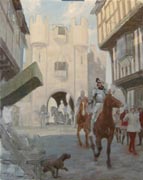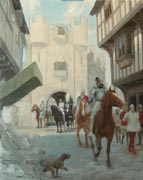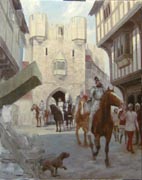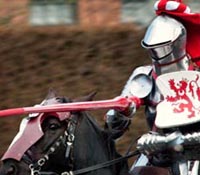
Click
image to enlarge |
With the first
coat of paint dry I am looking forward to really making some progress
this week. At the moment the painting looks very insubstantial
and thin. Before I start getting involved in detail I need to
add some form - establish areas of light and shade and then gradually
work up all the elements in relation to each other. However, as
you can see from the picture on the right, despite my best intentions
I have spent a fair chunk of the day working on the foreground
figures. It is difficult to avoid being drawn to a major part
of the picture like this, but I know
I shouldn't really be working on details such as the horseman's
face at this early stage.
I am
reminded why on Tuesday, when I realise that something isn't
quite right. After much deliberation I decide the foreground
figures (the ones I spent so long on yesterday) are too small
- not much, but enough to bother me.
It is tempting to leave them but I know I should put it right
now - at least I have noticed when only
a few hours have been wasted. So I take a rag to the picture
and wipe most of yesterday's
work off the canvas! Thank goodness oils allow this sort of
drastic action. Repainting the figures about ¼ inch bigger is
not easy as all the original lines are in the wrong place
and the paint is getting pretty sticky now, but at the end of
the day I am pleased I decided to make this change. Although
they look rather messy, I am happy that the figures are now
in proportion and fit into the scene. The surprising thing is
that everything still looks to scale in the sketch - I suppose
this shows you can get away with a lot when it is just roughly
indicated. It also demonstrates how important it is to keep
everything broad for as long as possible, leaving the detail
until everything looks 'right'. Unfortunately, 'right' is indefinable,
although I'm sure most people recognise when something looks
'wrong'.

Click
image to enlarge |
On
returning to the painting the following day, I am relieved to
find no other disasters jump out at me, so settle down
to what I hope will be a successful days painting. I tend to
work from right to left (as a left hander, I assume right-handed
artists work the other way), so consequently the next area to
receive my attention is the building on the right. To help emphasise
the claustrophobic
effect I am trying to convey, I have thrown a shadow from the
buildings on the left, across the street and half way up the
right hand building. This will also help make the sunlit
central group stand out. Before the day is over, I spend a little
time working on this group of figures, finding their proportions
also need altering in line with those in the foreground. Although
they are still fairly simple when I finish, the
shapes are now basically correct and I can return to them in
the future.

Click
image to enlarge |
As each
area of the painting is worked on, it highlights the deficiencies
in others, so I now turn my attention to the gate and add tone
and texture. While this scene has been created in my head (I
couldn't really paint this subject from
life!) I find it indispensable to refer to modern reality in
order to help make my view of the past look convincing. It might
sound obvious, but skies, trees, people, etc. are the same now
as they were 500 hundred years ago - something that would be
easy to overlook when getting bogged down in the minutiae of
historical detail. To flesh out my reconstruction of Bishopsgate
(which I am basing on a small drawing on the 'Copperplate map'
of c.1558 ) I refer to surviving structures, such as the city
gates at York. Painting rough stonework makes an enjoyable change,
allowing me to loosen up my style for at least one part of the
picture.
After the
slight trauma at the beginning of the week hopefully I have
now got the foundations correctly established and can continue
with confidence. The stall on the left is looking rather sparse,
so it will be next on the agenda.
Return
to Introduction
Back
to Week 1 - Forward to Week
3






